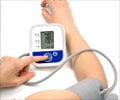- High blood pressure during childhood is a strong predictor of high blood pressure later in life and a risk factor of cardiovascular, metabolic and kidney disease and stroke.
- Maternal nutrition and cardiometabolic risk factors during pregnancy may influence the offspring’s cardiometabolic health including blood pressure.
- Recent findings suggest that higher levels of folic acid during pregnancy may decrease high blood pressure risk in children, even when pregnant mothers had cardiometabolic risk factors.
The prevalence of childhood elevated blood pressure has increased in the United States since 1980s, in particular among African Americans.
High blood pressure during childhood is a strong predictor of higher blood pressure later in life, and people with higher blood pressure are at greater risk of developing cardiovascular, metabolic and kidney disease and stroke.
Childhood Hypertension
There is no specific value for pediatric or childhood hypertension as it does not have a specifically assigned number.A child is considered hypertensive when the systolic or the diastolic blood pressure is more than or equal to 95th percentile of children of the same age, sex and height for more than 3 consecutive readings.
Since it is difficult to manage hypertension, diabetes and cardiovascular disease in adults, it is always better to identify early life risk factors for the prevention of such conditions; it can also be a cost-effective public health strategy.
Folate during Pregnancy
Maternal nutrition during pregnancy may influence offspring cardiometabolic health through its impact on the fetal intrauterine environment.Folate, is a B-vitamin that is present in various food sources. Folate is involved in processes like nucleic acid synthesis, gene expression, and cellular growth.
Folic acid is a form of folate, which is found in various food sources like citrus juices and dark green vegetables. Folic acid is necessary for production of new, healthy cells in the body.
In young adults, higher folic acid intake has been associated with a lower incidence of hypertension later in life.
Pregnant women are advised to consume 400 micrograms of folic acid supplements daily. It is essential to prevent important birth defects in the baby’s brain and spine.
Until the current study, no prospective birth cohort has examined the role of maternal folate levels, alone or in combination with maternal cardiometabolic risk factors on child blood pressure.
Study
For the study, researchers analyzed the data from a prospective United States urban birth cohort, that comprised mainly low-income racial and ethnic minorities, who were at a high risk for elevated blood pressure.They wanted to examine the individual and joint effect of maternal folic acid levels and cardiometabolic risk factors on offspring blood pressure.
Researchers included 1290 mother-child pairs, 67.8% of whom were Black and 19.2% of whom were Hispanic. They were recruited at birth and followed up to 9 years of age from 2003 to 2014 at the Boston Medical Center.
Around 38.2% of the mothers had one or more cardiometabolic risk factors:
- 14.6% had hypertensive disorders
- 11.1% had diabetes
- 25.1% had pre-pregnancy obesity
Children with higher systolic blood pressure were more likely to have mothers with pre-pregnancy obesity, hypertensive disorders, and diabetes.
Children with elevated systolic blood pressure were also more likely to have:
- lower birth weight
- lower gestational age
- higher BMI
The study findings suggest that higher levels of maternal folic acid help offset the adverse effect of maternal cardiometabolic risk factors on child systolic blood pressure.
Mothers who had any cardiometabolic risk factors but had folic acid levels above the median level gave birth to children who had 40% lower odds of elevated childhood systolic blood pressure.
"Our study adds further evidence on the early life origins of high blood pressure," said Dr. Xiaobin Wang, the study's senior corresponding author. "Our findings raise the possibility that early risk assessment and intervention before conception and during pregnancy may lead to new ways to prevent high blood pressure and its consequences across lifespan and generations."
The new article is published in the American Journal of Hypertension.
Hypertension in Children-Statistics
In U.S during 2003–2006, the prevalence of pre-hypertension among children and adolescents aged 8–17 years was approximately 14% in boys and 6% in girls.The prevalence of hypertension in childhood is about 4-5% and is slightly more common in the male child.
During 1997–2006, hospitalization rates for children and adolescents with a diagnosis of hypertension went up from approximately 18 cases per 100,000 pediatric hospital discharges in 1997 to approximately 35 cases per 100,000 in 2006.
A study in South India found that the prevalence of pre-hypertension and hypertension was similar in urban (2.9% and 2.8%) and rural (2.8% and 2%) school children in the age group of 10 to 16 years.
References:
- Xiaobin Wang et al. Association of Maternal Plasma Folate and Cardiometabolic Risk Factors in Pregnancy with Elevated Blood Pressure of Offspring in Childhood. American Journal of Hypertension; (year) DOI Link
- Hypertension in Childhood - (http://patient.info/in/doctor/hypertension-in-childhood)
- Hypertension Screening in Children and Adolescents — National Ambulatory Medical Care Survey, National Hospital Ambulatory Medical Care Survey, and Medical Expenditure Panel Survey, United States, 2007–2010 - (https://www.cdc.gov/mmwr/preview/mmwrhtml/su6302a8.htm)
- Pediatric Hypertension (High Blood Pressure in Children) - (https://www.medindia.net/patientinfo/pediatric-hypertension.htm)
- Folate - (https://ods.od.nih.gov/factsheets/Folate-Consumer/)
Source-Medindia
















